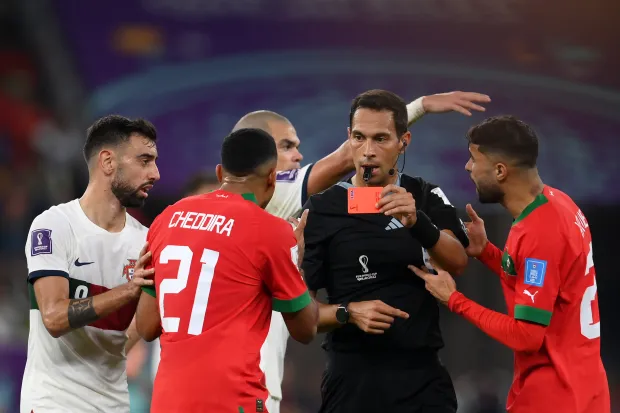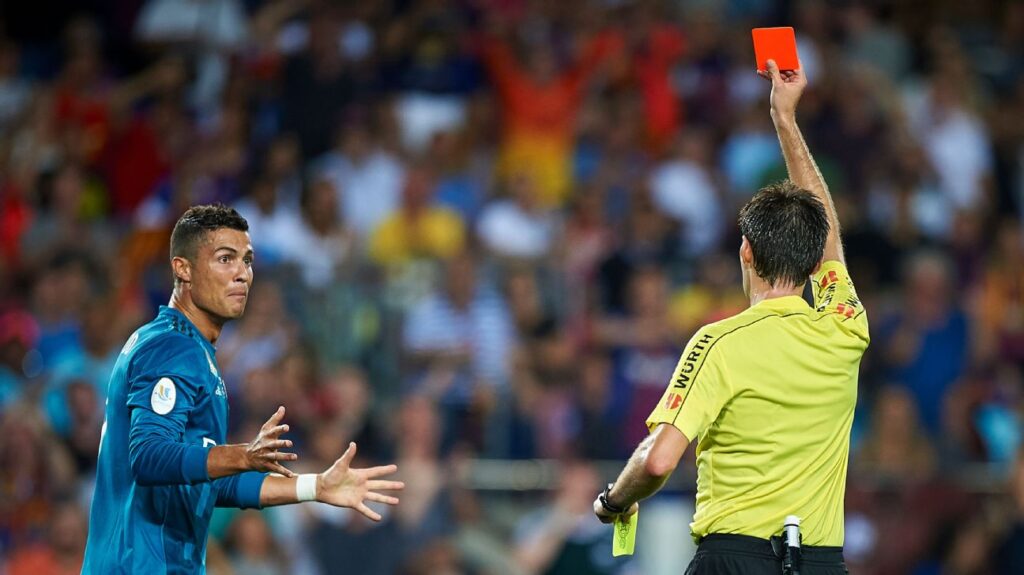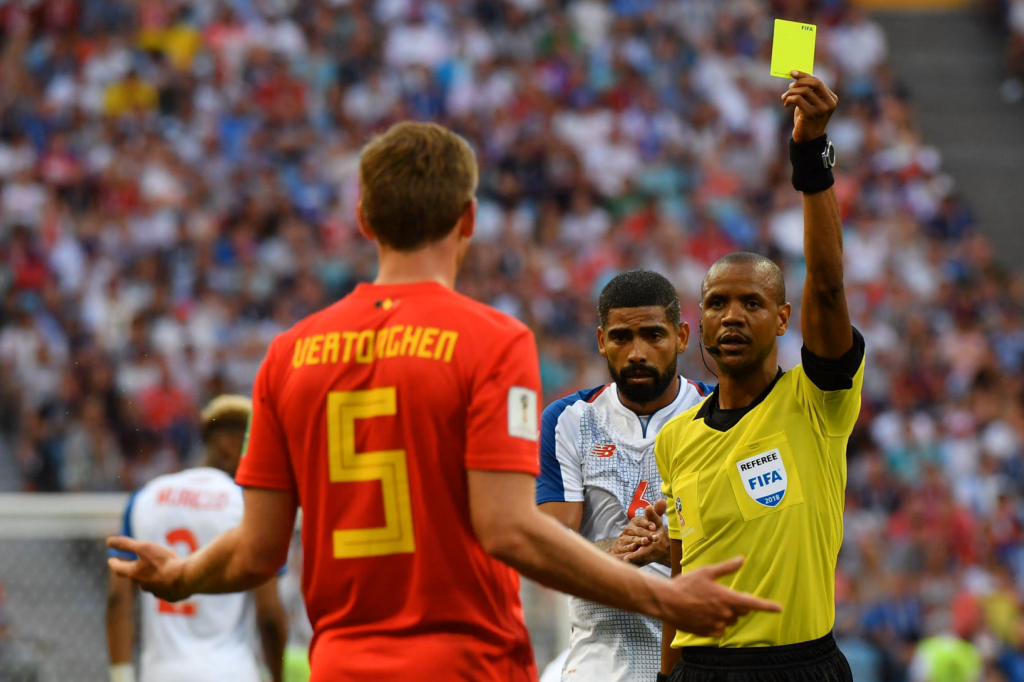Uncover the significance, impact and intricacies of red and yellow cards in football.
Red & Yellow Card in Football: A Deep Dive into Football Disciplinary
Football is a sport that is loved and played by millions of people worldwide. Along with the excitement and passion that comes with this popular game, there are also rules and regulations that players and fans must follow. One of the most important aspects of football discipline is the red and yellow card system, which serves as a warning and punitive measure for any player that violates the rules.
Understanding these disciplinary measures is crucial for players, coaches, fans and bettors alike. In this article, we will take a deep dive into the world of football discipline, with a particular focus on red and yellow cards. We will explore the history and origins of this system, the consequences of receiving a card, and the various sanctions that can be imposed.
Table of Contents
- 1 History & Origins of Cards
- 2 The Yellow Card
- 3 The Red Card: Understanding Its Significance in Football
- 4 The Yellow Card and Other Sanctions in Football
- 5 Key Differences
- 6 Card Statistics and Records
- 7 Field of Play and Offenses
- 8 World Cup and High Profile Matches
- 9 Conclusion
- 10 FAQ
- 10.1 What is the purpose of the red and yellow cards in football?
- 10.2 How are yellow cards accumulated throughout a match or season?
- 10.3 What offenses can lead to a red card?
- 10.4 What happens when a player receives a red card?
- 10.5 Are there any other sanctions that can be imposed besides red and yellow cards?
- 10.6 What are the key differences between red and yellow cards?
- 10.7 What are the rules concerning fouls and misconduct within the field of play?
- 10.8 Have there been any incidents involving red or yellow cards in past World Cup tournaments or high-profile matches?
History & Origins of Cards
The use of red and yellow cards as a disciplinary measure in football has a fascinating history that dates back several decades. The idea of using cards to penalize players for misconduct was first introduced in the English Football League in the early 1970s.
Before the introduction of cards, referees employed a range of disciplinary measures, such as verbal warnings, sending players off the field, or suspending them from future games. However, this often led to confusion and inconsistencies in decision-making, as well as protests from players, coaches, and fans.
In 1970, a referee named Ken Aston was struck with the idea of using cards to simplify the disciplinary process and make it more transparent for everyone involved. The inspiration came from his experience as a teacher, where he used colored cards to convey messages to his students.
During the 1970 World Cup in Mexico, Aston presented his concept to FIFA, and it was accepted for use in the tournament. The original system involved one red card used to signal a player’s expulsion from the match and two yellow cards to indicate a caution or warning for a minor misconduct.
Over time, the system has evolved, with new rules and interpretations added to accommodate different types of fouls and players’ behavior. Today, red and yellow cards are used across all levels of football worldwide, with minor variations in their application depending on the league, country, or competition.

The Yellow Card
The yellow card is an essential tool in football disciplinary measures used to caution players for minor fouls or misconduct. While a yellow card may seem like a relatively harmless offense, it is crucial to understand its significance in the context of the game.
Yellow cards serve to warn players to refrain from further fouls or misconduct that could result in more severe penalties. A player who accumulates two yellow cards during a match receives a red card and is sent off, significantly impacting their team’s chances of winning.
It is essential to note that yellow cards are not equal in severity and are not always issued for the same type of offense. The rules and regulations regarding fouls and misconduct that warrant a yellow card are subjective and open to interpretation by referees.
To illustrate this point, here is a table outlining the number of yellow cards issued for fouls and misconduct in the Premier League in the 2020-2021 season:
| Offense | Number of Yellow Cards |
|---|---|
| Unsporting behavior | 1,735 |
| Reckless challenges | 1,284 |
| Cynical fouls | 470 |
| Dissent | 408 |
As you can see from the table, unsporting behavior (which includes simulation and time-wasting) is the most common offense that results in a yellow card, followed by reckless challenges and cynical fouls. It is essential to understand the types of fouls and misconduct that warrant a yellow card to avoid receiving one during a match.
Yellow cards play a significant role in football disciplinary measures, and players must understand their significance to maintain fair play on the field. By cautioning players for minor fouls and misconduct, yellow cards serve as a warning to avoid more severe penalties that could result in a player’s sending off.
The Red Card: Understanding Its Significance in Football
The red card is the most severe disciplinary action that can be taken against a player in football. It is issued by the referee to indicate that a player must immediately leave the field of play and must take no further part in the game in progress.
The red card is typically issued for serious or violent misconduct on the field, such as intentionally harming an opponent, using excessive force, spitting at or verbally abusing another player, or denying an obvious goal-scoring opportunity through a deliberate handball.
When a player receives a red card, their team must continue the game with one fewer player on the field, making the game considerably more challenging.
Consequences of a Red Card
When a player is sent off with a red card, they are typically suspended for the next match or matches, depending on the severity of the offense. For example, if a player is sent off for two bookable offenses (i.e., two yellow cards), they will typically receive a one-match suspension. However, if a player is sent off for serious foul play or violent conduct, they may receive a longer suspension.
In addition to the suspension, the team of the player who received the red card is often fined, and may also face other disciplinary sanctions depending on the severity of the offense.
Notable Red Card Incidents
The red card has been the subject of many contentious and controversial incidents throughout football history. One such incident occurred during the 2006 World Cup final between France and Italy, when French midfielder Zinedine Zidane was sent off for headbutting an Italian opponent.
Another notable red card was issued to Manchester United defender Nemanja Vidic during a game against Liverpool in 2009, for a challenge that was deemed to be a professional foul.

The Yellow Card and Other Sanctions in Football
In addition to issuing yellow cards, referees and officials in football can impose a range of other sanctions in response to fouls, misconduct, and other violations of the rules of play. These include:
| Sanction | Description |
|---|---|
| Penalty Kick | A direct free kick awarded to the attacking team if a player commits a foul inside their own penalty area. |
| Free Kick | A kick awarded to a team following a foul or other violation, either direct or indirect depending on the nature of the offense. Indirect free kicks require the ball to touch another player before a goal can be scored. |
| Direct Free Kick | A free kick taken from the location of the foul, usually awarded for more serious offenses such as handball or dangerous tackles. |
| Indirect Free Kick | A free kick taken from the spot where the violation occurred, but where a goal cannot be scored unless the ball touches another player first. |
These sanctions are designed to ensure that players who violate the rules of the game are penalized in a way that is fair, appropriate, and consistent with the overall principles of football as a sport. By understanding how these sanctions are applied, players, coaches, officials, and fans alike can gain a deeper appreciation for the importance of maintaining discipline and sportsmanship on the field of play.
Key Differences
Understanding the key differences between red and yellow cards is essential in comprehending football disciplinary measures. While both cards serve to maintain discipline and fairness in the game, they differ in the severity of the offense committed and the consequences imposed on the player or team.
Red Cards
A red card is issued by the referee to a player for committing serious offenses, such as violent conduct, denial of an obvious goal-scoring opportunity, or using offensive language or gestures. When a player receives a red card, they are immediately sent off the field and cannot be replaced by a substitute.
| Offenses Leading to a Red Card | Consequences |
|---|---|
| Violent conduct | Immediate expulsion from the match and a suspension for the following matches |
| Denial of an obvious goal-scoring opportunity | Immediate expulsion from the match |
| Using offensive language or gestures | Immediate expulsion from the match and a possible additional suspension |
Yellow Cards
A yellow card is given to a player by the referee for committing an act of misconduct or a foul. It serves as a warning that further actions of this nature may result in a red card. If a player receives two yellow cards in the same game, it is equal to receiving a red card, and they will be sent off the field.
| Offenses Leading to a Yellow Card | Consequences |
|---|---|
| Dissent towards the referee’s decisions | Verbal warning or a yellow card |
| Delaying the restart of play | Yellow card |
| Reckless challenges | Yellow card or red card, depending on the severity |
It is important to note that a yellow card does not carry any immediate consequences, but if a player accumulates a certain number of yellow cards throughout a season, they may face a suspension.

Card Statistics and Records
Red and yellow cards have become a fundamental part of football disciplinary measures since their introduction in 1970 by the Football Association. Over the years, these cards have been the subject of many controversies and have even affected the outcome of some games. Here are some interesting card statistics and records:
| Record | Player/Team | Number |
|---|---|---|
| Most Red Cards in a Premier League Season | Vinnie Jones | 12 |
| Most Yellow Cards in a World Cup | Sime Vrsaljko | 4 |
| Fastest Red Card in Premier League History | Jonathan Woodgate | 13 seconds |
| Most Red Cards by a Team in a Single Premier League Game | Manchester City | 3 |
Interestingly, the 2006 World Cup saw the most red cards issued in a single tournament, with 28 players being sent off. The 2010 World Cup in South Africa saw the fewest red cards in history, with only 17 players being sent off.
The record for the most red cards issued in a single game is held by the match between Sportivo Ameliano and General Caballero in Paraguay in 1993, where a total of 20 players were sent off.
It is worth noting that players who receive two yellow cards in a single game are sent off, and it is considered as a red card. The total number of yellow cards issued in a tournament or season is also a crucial statistic that showcases the nature of the game. For instance, in the 2018 World Cup, a total of 219 yellow cards were issued, indicating the physicality and competitiveness of the tournament.
Ultimately, these card statistics and records highlight the importance of maintaining discipline on the field and the significant role played by football disciplinary rules in shaping the game’s outcome.
Field of Play and Offenses
The game of football is governed by specific rules and regulations that outline the expected behavior of players on and off the field. Understanding these rules is crucial for maintaining discipline and fair play in the game.
Required Distance between Opposing Players
During set-pieces such as free kicks or corner kicks, opposing players are expected to maintain a specific distance from the ball until it is in play. This distance is set at a minimum of ten yards or 9.144 meters and failure to comply with this rule will result in a foul being called against the offending player.
Fouls and Misconduct
A foul is committed by a player when they use excessive force or make contact with an opponent in an attempt to gain an advantage. Misconduct, on the other hand, refers to actions taken by a player that goes against the spirit of the game and disrupts the flow of play.
Serious Foul Play
Serious or violent foul play, which includes reckless challenges, tackles from behind, and dangerous tackles, can result in a player receiving a yellow or red card, depending on the severity of the offense.
Own Penalty Area
When a team commits a foul within their own penalty area, the opposing team is awarded a penalty kick. The defending team is expected to ensure that any defending players remain at least ten yards away from the penalty kick taker until the ball is in play.

World Cup and High Profile Matches
The year’s World Cup and high-profile matches are where the stakes are highest, and disciplinary actions can have the most significant impact. Even a single red card or yellow card can dramatically alter the outcome of a game, affect the opposing team’s morale, and stay in players’ memories for years to come.
One such incident occurred during the 2006 World Cup quarterfinal between Portugal and England, where Portuguese star player Cristiano Ronaldo was involved in a controversial incident that resulted in England’s Wayne Rooney being sent off. Ronaldo was accused of pressuring the referee into showing the red card to Rooney, his Manchester United teammate. The incident created a significant stir in the media and among fans, showcasing how emotional and divisive disciplinary decisions can be in high-pressure situations.
The same player, Cristiano Ronaldo, was involved in another incident during the 2018 World Cup, where he received a yellow card in Portugal’s match against Spain. The yellow card was controversially reversed, leading to massive uproar among fans and analysts alike. Spain’s technical staff and players were furious, arguing that the referee caved to Ronaldo’s pressure and changed his initial decision. The incident highlights the importance of effective and consistent refereeing, especially in high-profile matches where the stakes are high, and emotions run rampant.
These examples underline how red and yellow cards continue to play an essential role in maintaining discipline and fair play in football’s most critical games. The Football Association and other governing bodies must ensure that disciplinary decisions are fair, transparent, and consistent, especially in events as significant as the World Cup.
Conclusion
In conclusion, the red and yellow cards play a crucial role in maintaining fair play and discipline in football. It is essential to understand the disciplinary measures and the consequences of receiving a red or yellow card. The Football Association enforces the disciplinary rules and regulations, ensuring that the game is played within the specified guidelines.
Fair play is at the core of football, and red cards are issued for serious offenses, such as violent conduct or deliberate fouls, which threaten the safety of players. On the other hand, yellow cards are issued for minor fouls or misconduct, cautioning the player to modify their behavior.
The Football Association has been instrumental in promoting fair play and good sportsmanship in football, and their efforts have helped in making the game more enjoyable and rewarding for players and fans alike. It is imperative to respect and abide by the rules and regulations set by the Football Association, which will lead to a better understanding and appreciation of the game.
Football is a game that brings people together, and fair play is essential to ensuring a level playing field where teams can compete without fear or favor. The red and yellow cards are a necessary tool in achieving this goal, and players must respect and abide by these disciplinary measures for the betterment of the game and its participants.
FAQ
What is the purpose of the red and yellow cards in football?
The red and yellow cards are used to indicate disciplinary measures in football. The yellow card is a cautionary card given for minor fouls or misconduct, while the red card signifies a player’s dismissal from the game due to serious offenses or accumulation of multiple yellow cards.
How are yellow cards accumulated throughout a match or season?
Each time a player receives a yellow card, it is recorded against their name. If a player accumulates a certain number of yellow cards within a specified period, they may face additional sanctions or suspensions.
What offenses can lead to a red card?
A red card is typically given for severe offenses such as violent conduct, serious foul play, or denying an obvious goal-scoring opportunity. It can also be shown for excessive fouls or receiving a second yellow card in the same game.
What happens when a player receives a red card?
When a player is shown a red card, they are immediately sent off the field and their team is reduced to playing with one less player. The team may also face additional consequences, such as a penalty kick awarded to the opposing team.
Are there any other sanctions that can be imposed besides red and yellow cards?
Yes, there are additional sanctions that can be imposed following a red or yellow card. These include penalty kicks, free kicks, or the awarding of direct or indirect free kicks depending on the nature of the offense.
What are the key differences between red and yellow cards?
Yellow cards are cautionary and indicate a warning for minor fouls or misconduct, while red cards signify a player’s dismissal from the game for serious offenses. Multiple yellow cards can lead to a red card.
What are the rules concerning fouls and misconduct within the field of play?
Within the field of play, players are required to maintain a certain distance from opposing players during set-pieces and are restricted from engaging in serious foul play within their team’s own penalty area. Violations can result in fouls being awarded or penalties given.
Have there been any incidents involving red or yellow cards in past World Cup tournaments or high-profile matches?
Yes, past World Cup tournaments and high-profile matches have witnessed various incidents involving red and yellow cards. These incidents have often sparked controversy and impacted the outcome of the games.


















